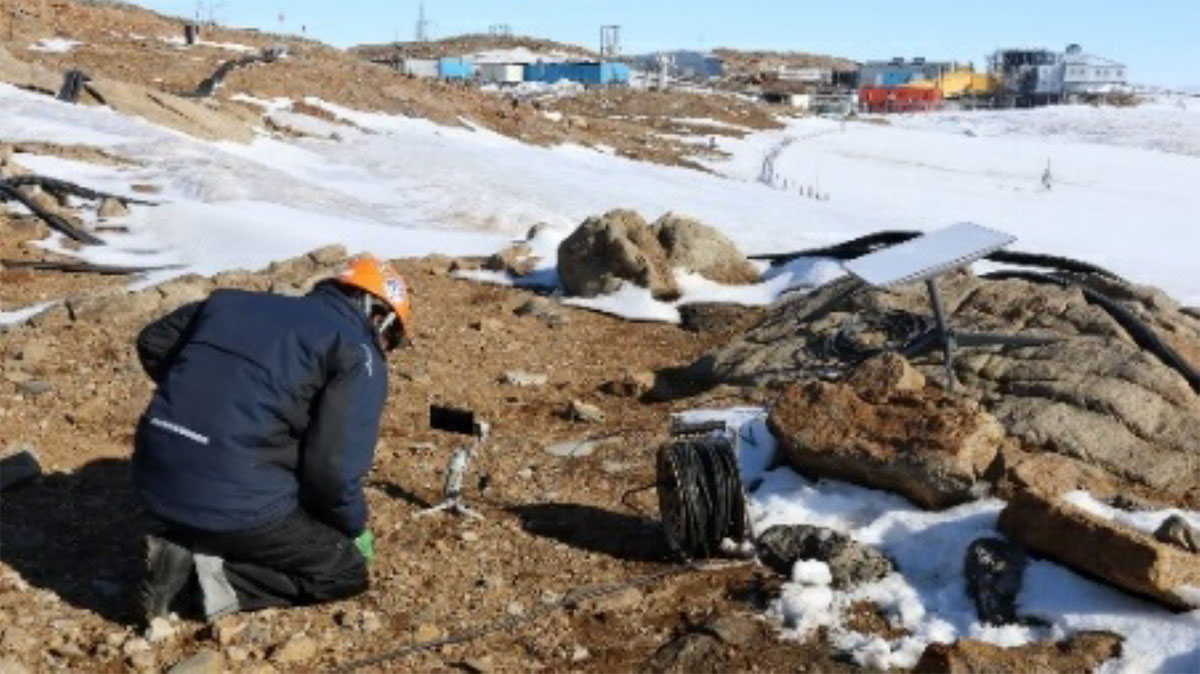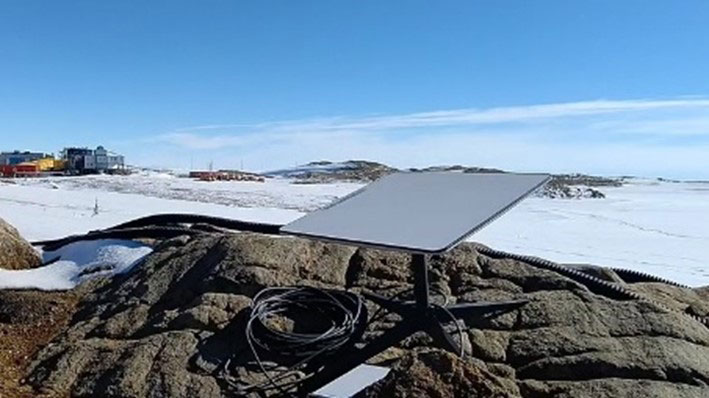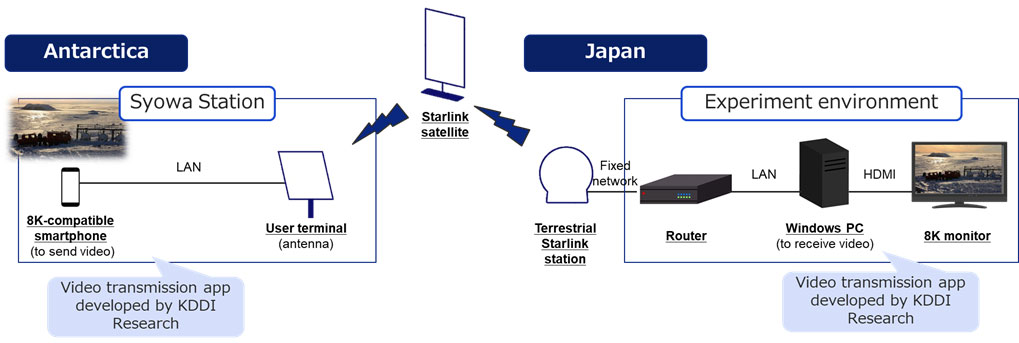National Institute of Polar Research
Real-time Transmission of 8K Video from Antarctica via Starlink a Success
For DX of Antarctic expedition members' work and for support for releasing news
February 26, 2024
KDDI Corporation
KDDI Research, Inc.
Inter-university Research Institute Corporation Research Organization of Information and Systems,
National Institute of Polar Research
On February 13, 2024, KDDI Corporation (“KDDI”), KDDI Research, Inc. (“KDDI Research”) and Inter-university Research Institute Corporation Research Organization of Information and Systems, National Institute of Polar Research (“NIPR”) successfully completed a verification experiment in which an 8K video was transmitted in real time via Starlink satellite communication between Syowa Station in Antarctica and KDDI Research's head office.
Starlink provides a high-speed, low-latency network even near Syowa Station. Making the most of the portability of Starlink's user terminal (antenna) (*1), expedition members can utilize the network not only at the station and in its environs but in wider areas as well for various purposes such as nature observation in Antarctica as well as improving work efficiency through communication between expedition members located far from the station and representatives in Japan.

An expedition member sending an 8K video from a location near Syowa Station

Installing a Starlink antenna

Comparison of video quality (left: 8K video; right: 2K video)
KDDI and KDDI Research will use Starlink (developed by SpaceX) to help improve the operational environment for expedition members in Antarctica, NIPR's research and observation work, and the building of a communication environment in Antarctica as well as the advancement of its educational services in order to play a part in solving worldwide issues such as global warming. The parties will also verify the effectiveness of the smartphone-based real-time 8K video transmission system as well as identify and improve issues so that the system can be accessed from anywhere on the planet regardless of communication line speed. This will contribute to maintaining social infrastructures and securing their robustness because on-site DX can be accelerated and advanced.
NIPR will utilize Starlink's broad bandwidth and low-latency communication lines to further sophisticate observation at Syowa Station. The l
ines will be used not only for observation of the North and South Poles but for global observation to reduce the workloads of expedition members, increasing the potential for globally collaborated observation as well as collaboration in observing space projectiles.
KDDI will introduce scenes from this experiment at its booth at MWC Barcelona 2024 ("MWC"), the world’s largest mobile-related tradeshow that opens on February 26, 2024 in Barcelona, Spain (*2).
Background
In Antarctica, there are approximately 40 stations (wintering stations) that conduct observation work throughout the year by monitoring and researching various domains, including the weather, the atmosphere, snow and ice, geological features, organisms, oceans, and space physics.
In 2004, Japan's Syowa Station installed an INTELSAT telecommunication satellite system, which has been used to advance research by constantly transmitting observed data to Japan as well as to enhance the welfare of expedition members. It has also been used to release news to primary and secondary schools in Japan, schools around the world, and to the public. In the beginning, it had a speed of only around 1 Mbps, but by November 2022, the speed had been increased up to 7 Mbps, broadening the scope of application.
Since 2004, videos had been transmitted via INTELSAT, but the video quality was at best HDTV, and there was a need for higher-definition video for remote medical support that connected Syowa Station to hospitals in Japan via satellite linkage as well as for expedition members' communication with their faraway families. Better video quality was also required because needs were growing for the station to release more news for educational purposes.
On November 11, 2022, in a world first, KDDI Research and NIPR successfully transmitted an 8K video in real time from Antarctica (*3). What supported this venture was the call for advancing technologies in Antarctica in order to ensure the safety and DX of expedition members' operations, not just at and around Syowa Station with the INTELSAT antenna but even when expedition members went away for monitoring work, so that they could be reached instantly and meteorological information could be sent in a timely manner.
Overview of this experiment
1. Date of implementation
February 13, 2024
2. Purpose
Through real-time transmission of Starlink-based high-definition video, verify technology for showing the health conditions and daily scenes of expedition members, as well as the nature and environment of Syowa Station to Japan and the wider world.
3. Evaluated content
・Use of video transmission equipment at Syowa Station
・Quality of the received video
・Transmission bandwidth control technology and packet loss adjustment technology to send high-definition video efficiently via Starlink satellite communication
4. System configuration
At Syowa Station, a video was taken on a smartphone and compressed with VistaFinder Mx, a system that supports shooting 8K video, and the video was then sent via satellite communication. The video was received and played back by a reception system at KDDI Research, which displayed the video as an 8K video on a monitor, thus confirming that steady video quality was maintained.

System configuration of the 8K video transmission
VistaFinder Mx, the remote-work support system developed by KDDI Research that enables real-time transmission of 8K video, employs the global-standard video codec H.265/HEVC. It can reduce data volume while maintaining video quality, achieving quality video transmission even in a satellite communication environment.
5. Representatives of the experiment
Gen Hattori (KDDI Research)
Kei Kawamura (KDDI Research)
Tomohiro Obara (KDDI Research)
Tomohiro Tsuji (KDDI)
Masaki Okada (Information Infrastructure Center, NIPR)
Hiroyuki Fujino (Antarctic Observation Center, NIPR)
6. Work representatives at Syowa Station
Naoto Tsumachi (65th Japanese Antarctic Research Expedition Wintering Party, posted from KDDI to NIPR and then further posted to the expedition team) and Terufumi Nakamura (64th Japanese Antarctic Research Expedition Wintering Party, posted from KDDI to NIPR and then further posted to the expedition team) were responsible for shooting the 8K video for the experiment.
This experiment was part of KDDI Research's and NIPR's "Experiment for research and development of new video transmission technologies for data recording and news release by the Antarctica expedition team, as well as for releasing innovative PR videos to the public," which has been conducted since 2019.
(*1) Use of the Starlink satellite communication user terminal requires a power source.
(*2) KDDI MWC Barcelona 2024 special website
https://www.kddi.com/english/mwc2024/
(*3) KDDI Research news release, December 15, 2022
Success in the World's First Real-time 8K Video Transmission from Antarctica―To improve the expedition team's living conditions and to share news (in Japanese only)
https://www.kddi-research.jp/newsrelease/2022/121501.html







